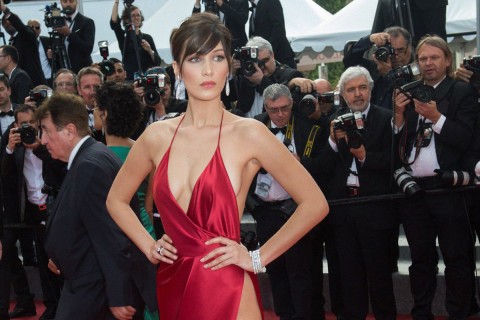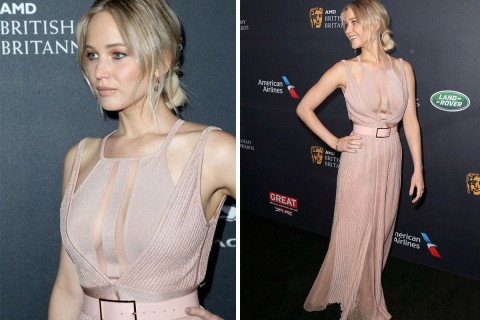It’s official – cleavage is over. Vogue has declared it, and therefore it must be true. The era of ideal breasts being perfectly spherical and elevated by a heavily engineered bra is done, according to the fashion bible.
High-collared or more gently scooped necklines and a more natural breast shape – as recently demonstrated by actresses such as Alicia Vikander and Jennifer Lawrence – are favored by the high-fashion gods these days, in what has been noted as a return to the “’70s boob.” Strong clavicles and the sternum have been declared the current female body features to be displayed and desired.
Having been “shorthand for allure” for the last 20-25 years, the move away from prominent cleavage is a significant shift in what is categorized as desirable about the traditionally-female body. One of the central reasons for Vogue’s existence is to make declarations on what is trending and what is not, but this kind of trend – the celebration or otherwise of a certain body shape, type and or look – is more troubling than the traditional seasonal declarations of must-have color palettes and fabrics.
Most people are happy to go out and replace a handbag or shirt in an outdated style for a new one; if you’re a busty woman and you find that your body shape is suddenly declared passé, what can you do about that?
Before discussing whether cleavage is over or not (and whether we should care or not), part of Vogue’s reasoning for exposed cleavage being on the decline needs to be addressed. According to stylist Elizabeth Saltzman, cleavage is over due to creeps on Instagram. She notes that whenever female celebrities post cleavage-revealing photos on Instagram, 90% of the comments are leery observations about said cleavage.
However, the idea that the solution to preventing lecherous comments being made about a woman’s body is for that woman to cover herself is suspicious, to say the least – surely the solution is for creeps to stop being creeps.
Kevork Djansezian / Getty
She is not to blame for the sleazy comments being made about her body. She is responsible only for making herself feel and look however the hell she wants to, and if that involves her getting her “tits out for the lads” (or whoever she wants to see them), that’s entirely up to her. It is sadly defeatist of Saltzman to concede that comments made by other people on a woman’s body are that woman’s responsibility to manage, particularly from such a high-profile platform such as Vogue.
Our cavemen ancestors used to select partners based on practical survival stuff like wide hips for fertility and broad shoulders for strength. However, since we have more or less assured the survival of our species, much more superficial features have been declared as ideal. Piled-up cleavage has been “the thing to do with your boobs” from 1994, when model Eva Herzigova shot the infamous “Hello Boys” advert for Wonderbra.

Wonderbra
Buzzfeed produced a popular video in 2015 featuring the female body types celebrated as ideal throughout 3,000 years of history. If you’re a woman with rounded stomach and fair skin, you’d have slayed in renaissance Italy. The ideal woman in Victorian England was apparently “desirably plump,” as a well-fed woman was usually a wealthy one.
While the video was widely praised for pointing out that everybody was ideally beautiful at some point, a broader point seemed to be missed – why should any body type be more celebrated than the rest at all? What’s with society’s obsession with an ideal body shape?
It’s all very well and good to point out that the body of the “ideal woman” has changed significantly as our society goes through its ups and downs. However, the one thing that all these ideals have had in common is that next to nobody can achieve them. Any ideal will always leave large swathes of women feeling inadequate.
While smaller-breasted women may now be rejoicing at being more able to embrace and celebrate their natural shape, bigger breasted women (including those who’ve opted for enhancement surgery to achieve this particular ideal of beauty) might start feeling like they are no longer as desirable as they once were. Either way, someone loses. Society’s selection of an ideal body type or a most desirable feature always creates an opposite: a range of non-ideal and less desirable body types.

Victor Hugo / Patrick McMullan / Getty
Fashion-conscious women of all sizes will soon be investing in appropriately on-trend clothing with features such as deep-V necklines, which brings attention to the sternum, upper chest and clavicles rather than the breasts. If you’re a woman with larger breasts, however, buying new clothes won’t solve the “problem” of your cleavage being off trend.
One thing needs to be made clear – choosing to display prominent cleavage is not the same as having big breasts. While fashion has been amenable to cleavage since the ’90s, it has never catered particularly well for women with large breasts – most designer clothing was (and continues to be) designed for women with slim, compact builds.
Cleavage was to be artificially engineered with the help of Wonderbras and structural elements such as corsetry and boning. Designs didn’t account for the broader shoulders and chests that often accompany larger breasts, because it didn’t view a stronger female build as ideal.

DKNY
Often the only way for women with cup sizes D and above to be comfortable in designer clothing is for your breasts to be on display, so the “deep cleavage = attractive” ideal is convenient for larger-breasted women when they want to feel sexy.
However, any larger-breasted woman will tell you of numerous occasions where attempts to simply dress comfortably and appropriately for your day to day business can cause people to think that you are deliberately exposing your breasts to attract attention. Work shirts are often instantly and unintentionally provocative, as many shirts won’t comfortably button over a D+ sized bust. Even sports bras can uncomfortably force breasts together, or leave them unsupported from underneath.
The upshot of all this is that larger-breasted women who buy on-trend clothing designed to show off the sternum and clavicles will probably end up showing cleavage regardless, because big boobs will generally produce cleavage, whether you want them to or not.
Similarly, a more natural, less supported “’70s boob” is not necessarily achievable: women with larger breasts need more supportive bras to be comfortable, as unsupported breasts can cause significant discomfort. The equally on-trend loose fit look is also hard if you have a larger bust, as in order to obtain a loose fit around the chest, the sizing in the rest of the garment is often far too big.

Vivienne Westwood
Clothing seems to be designed for how women should look, rather than how they want to feel. At times there seems to be very little middle ground for women who wish to be on trend, confident and comfortable. Even guides to dressing for your body type, which often tout themselves as body positive, seek to undermine individual body confidence by containing thinly-veiled ideals to be achieved; every body shape has a “goal” to “show off your curves,” “smooth out your thighs” or “minimize your mid-section.”
As Charles Manning of Cosmopolitan puts it, “these stories break the body down into a set of problems that need to be solved.” He makes the very valid point that fashion should be about self-expression and fun, rather than using clothes to create the illusion of a body that you don’t have.
Thinking more deeply about trends, you quickly realize that we all lose if we buy into what trends say about our bodies, and whether your particular shape is labelled on-trend, desirable or neither. That’s not to say that we should ignore trends and wear hessian sacks for all time – we just need to remember that fashion should be about clothes, not bodies.
Finding someone who embraces and loves every single trending look is as unlikely as finding someone whose body will suit every single trending look. Every body is different, and there are plenty of ways you can experiment with various aspects of a trend to make it work in a way that is comfortable and cool for you – if you feel like that trend fits your particular vibe. If it doesn’t work for you, that doesn’t mean that you are unattractive until your body type becomes trendy again.

Samir Hussein / WireImage
Men and women who find big breasts attractive are still going to find big breasts attractive, whether they’re covered by a Victorian high-collared lace blouse or openly on display in a tiny triangle bikini. Equally, people who have always found a set of defined clavicles or wider-set, cleavage free breasts hot haven’t only just started to like them because they’re trending.
We don’t shut off our instinctive attraction to certain physical attributes just because Vogue says they’re not cool anymore; we aren’t wired like that. Is Christina Hendricks now going to be labelled a hideous hag because her arguably most famous feature is no longer on-trend? Of course not. She will continue to be beautiful, as will others with a wide variety of different body types.
Dressing to achieve and project your best levels of confidence is a better bet than slavishly following every trend no matter how unachievable it is for your body – and the former is always in style.
For more on the topic of women’s bodies, check out how the body positive movement went from fringe to mainstream.
-
Lead image:
Daniel Jackson

